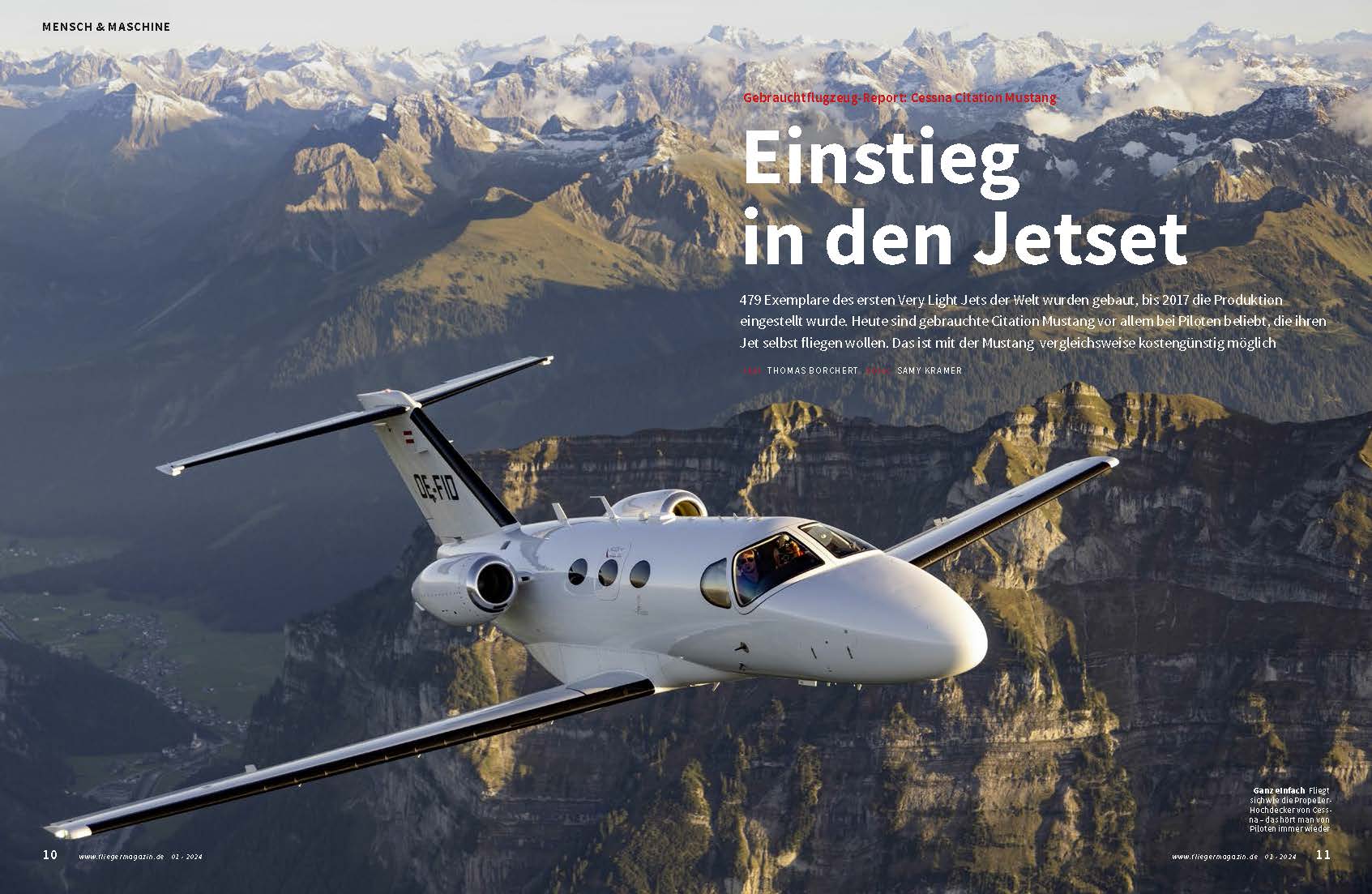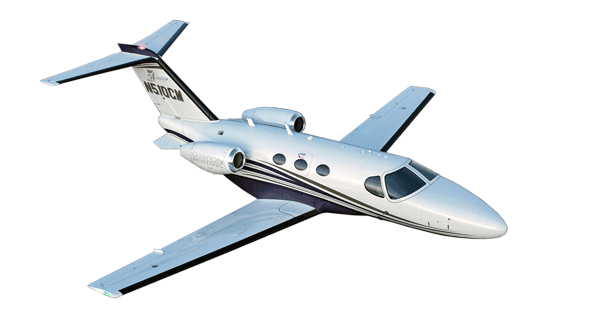Aircraft Report: Cessna Citation Mustang
fliegermagazin No.1 - January 2024 (german)
The Cessna Citation Mustang was presented in detail in the January issue of fliegermagazin.
You can read
the entire article here.


With kind permission of fliegermagazin | fliegermagazin.de
Cessna Citation Mustang C510
 Maintenance Addresses &
Contacts
Maintenance Addresses &
Contacts

The Cessna Citation Mustang (Model 510) is a very light jet built by Cessna. Launched at the 2002 NBAA convention, it first flew on 23 April 2005. It received its FAA type certification September 8, 2006, was first delivered on November 22 and production ended in 2017 after 479 aircraft were built. The 8,645 lb (3,921 kg) MTOW jet is powered by two 1,460 lbf (6.5 kN) P&WC PW615F turbofans, can reach 340 kn (630 km/h) and can cover 1,167 nmi (2,161 km).
Development
Launched at the 2002 NBAA convention, the $2.4 million Mustang first flew on 23 April 2005. The airplane received full type certification from the Federal Aviation Administration on September 8, 2006. Cessna received FAA certification to fly into "known icing conditions" on November 9, 2006. Cessna delivered the first production LJ on November 22, 2006, the same day the FAA awarded Cessna with the necessary certification. Dave and Dawn Goode of GOODE Ski Technologies received the first retail delivered Cessna Mustang on April 23, 2007.
In 2010, Cessna launched an enhanced edition of the aircraft called the High Sierra, which features higher quality cabin furnishings and enhanced avionics, including synthetic vision.
Cessna ended production of the design in May 2017. Production ended due to lack of customer demand for the aircraft, as a result of competition from the company's own Cessna Citation M2. The company had been selling an average of 40 Mustangs per year until the M2 was introduced in 2013 and then Mustang sales dropped to just 24 aircraft over the next three years. The M2 is a faster and larger aircraft, but can operate from similar length runways and requires only a single pilot with the C/E-525 type rating, which reduced training and crewing costs over the Mustang. A total of 479 examples of the Citation Mustang were produced.
Design
The Mustang is a low-wing cantilever monoplane with a swept wing, T-tail and retractable tricycle gear. One main door is located in the forward left section of the aircraft, with an additional emergency exit on the center right section of the fuselage. The Mustang, in standard configuration, has four passenger seats in the aft cabin, a toilet, and seating for two in the cockpit. The airframe is primarily of aluminum alloy construction, with a three spar wing. Power is provided by two Pratt & Whitney Canada PW615F turbofans, mounted in pods on the aft fuselage. It is built at the Cessna production facility in Independence, Kansas.
Like many other light jets, the Mustang is approved for single-pilot operation.
| Role: | Businessjet |
| National origin: | United States |
| Manufacturer: | Cessna |
| First flight: | 23rd April 2005 |
| Introduction: | 23rd November 2006 |
| Produced: | 2005–2017 |
| Number built: | 479 |
Technical specifications
| General characteristics | |
|---|---|
| Crew | 1–2 |
| Passager capacity | 4–5 |
| Landing distance | 725 m |
| Takeoff distance | 948 m |
| Unit cost (new, 2013) | 3,2 Mio. US-Dollar |
| Years of construction and quantities | 2006 - 2016, 479 pieces |
| Operating cost | 725 US-$ per hour |
| Power plant | 2 × Pratt & Whitney PW615F-A |
| Dimensions | |
| Length | 12,37 m |
| Wingspan | 13,16 m |
| Height | 4,09 m |
| Cabin Length | 2,97 m |
| Cabin height | 1,37 m |
| Cabin width | 1,4 m |
| Luggage capacity | 1,8 m³ |
| Mass data | |
| Empty weight | 2439 kg / 5376 lbs |
| Max. payload | 623 kg / 1374 lbs (MZFM = 6750 lbs) |
| Max. takeoff weight | 3921 kg |
| Max. landing weight | 3629 kg |
| Performance | |
| Cruise. Speed | 630 km/h |
| Range | 2130 km (NBAA IFR, 100 NM Alternate |
| Service ceiling | 41.000 ft (12.500 m) |
| Thrust | 2 × 6,50 kN (1460 lbs) |
Source for this page:
https://de.wikipedia.org/wiki/Cessna_Citation_Mustang
https://en.wikipedia.org/wiki/Cessna_Citation_Mustang
Lizenz:
https://creativecommons.org/licenses/by-sa/3.0/deed.de
